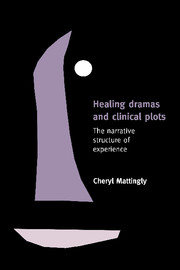Book contents
- Frontmatter
- Contents
- Preface
- Acknowledgments
- 1 Finding narrative in clinical practice
- 2 The mimetic question
- 3 The checkers game: clinical actions in quest of a narrative
- 4 Therapeutic plots
- 5 The self in narrative suspense: therapeutic plots and life stories
- 6 Some moments are more narrative than others
- 7 Therapeutic plots, healing rituals, and the creation of significant experience
- Notes
- References
- Index
5 - The self in narrative suspense: therapeutic plots and life stories
Published online by Cambridge University Press: 05 June 2012
- Frontmatter
- Contents
- Preface
- Acknowledgments
- 1 Finding narrative in clinical practice
- 2 The mimetic question
- 3 The checkers game: clinical actions in quest of a narrative
- 4 Therapeutic plots
- 5 The self in narrative suspense: therapeutic plots and life stories
- 6 Some moments are more narrative than others
- 7 Therapeutic plots, healing rituals, and the creation of significant experience
- Notes
- References
- Index
Summary
At their best, therapeutic plots provide experiments in considering who one might be, even with a disability. But rarely do they offer decisive answers to the questions, “Who am I now?” or “Who will I become?” Their messages are fraught with ambiguity, images in the subjunctive mode (Good and Good 1994; Bruner 1986, 1990; Iser 1974, 1978). Illness trajectories are notoriously uncertain (Becker and Kaufman 1995; Casper and Koenig 1996). Diagnoses may offer some parameters which constrain what therapists, patients and kin may reasonably hope for, but treatment is often an on-going guessing game in which prognoses are revised as the illness is lived out (Good 1995). Bodily uncertainty is compounded by the phenomenological uncertainty which characterizes rehabilitation, often forcing even the reluctantly reflective to ponder the meaning of their lives. Illness can mark an intensely contemplative time, an irrevocable and unmistakable turning point. When illness or injury will be followed by disability, the turning point cannot be avoided.
This chapter takes up in a more explicit and careful way what has been reiterated all along, that therapeutic plots and life plots are irrevocably intertwined. In doing so, it addresses a number of central anthropological assumptions about what makes a self and what narrative has to do with it.
Narrative and the coherent self
Anthropological thought has taken some rather complicated turns in considering the self as narratively configured.
- Type
- Chapter
- Information
- Healing Dramas and Clinical PlotsThe Narrative Structure of Experience, pp. 104 - 128Publisher: Cambridge University PressPrint publication year: 1998



